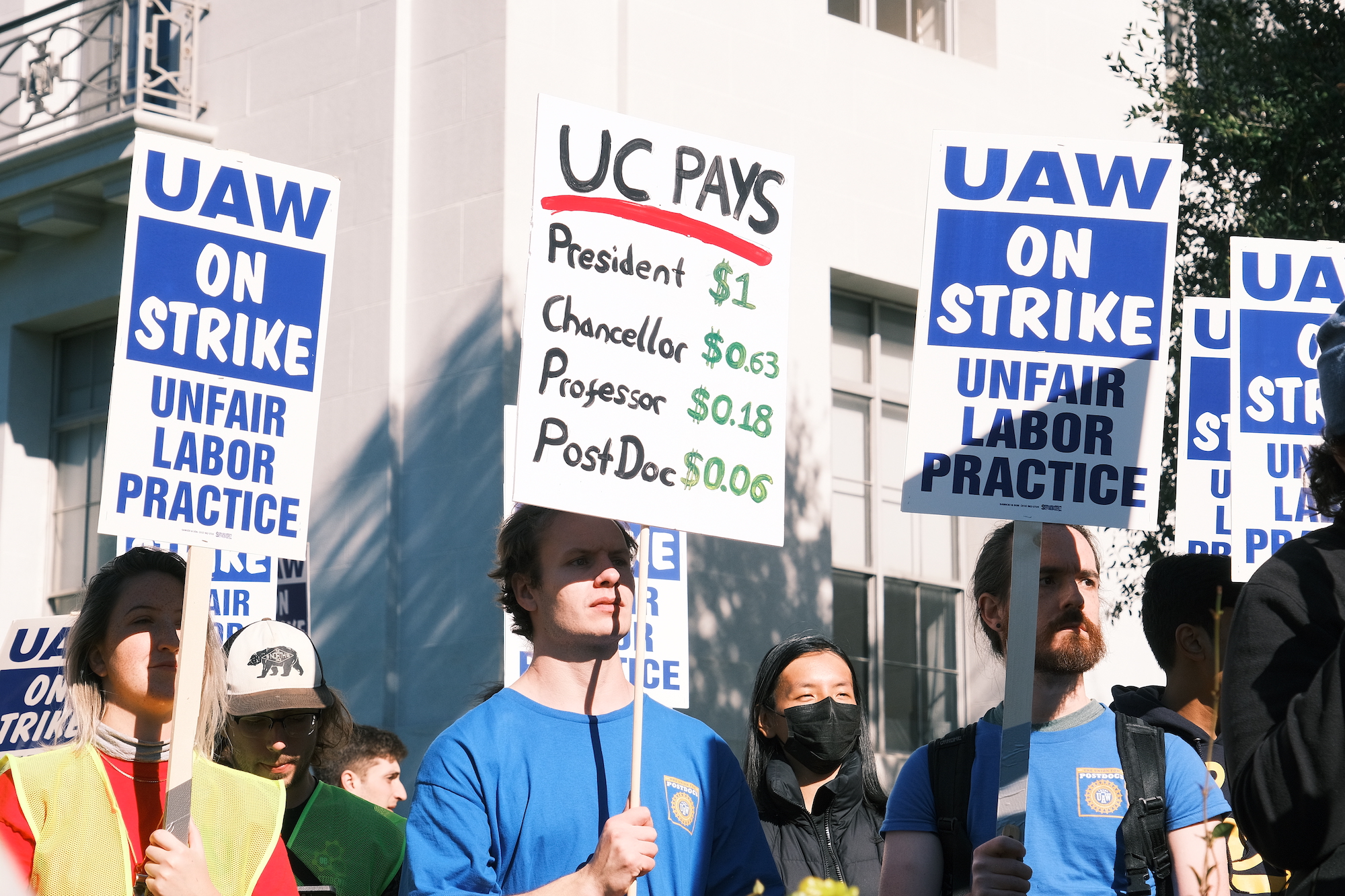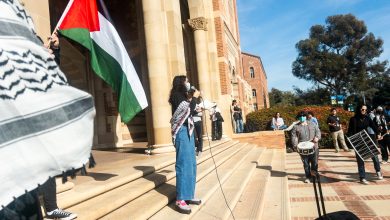UC Strike Primer

From a collection of images made available for press use by Fair UC Now
Image description: A crowd of strikers at UC Berkeley stands with their eyes fixed in the same direction. They hold blue-and-white signs saying “UAW On Strike: Unfair Labor Practice” (punctuation added), and two are wearing blue union shirts. The person in the middle has a handmade sign saying “UC Pays: President $1, Chancellor $0.63, Professor $0.18, Postdoc $0.06” (punctuation added).
On Monday, Nov. 14, 2022, 48,000 student workers across all nine UC campuses walked off the job, making history as the largest strike in higher education in the United States. At the picket lines, striking workers marched, chanting “What’s disgusting? Union busting! What’s outrageous? Poverty wages!” to percussive backing. Nearby, I spoke to UCLA student and Campaign Coordinator of the campus chapter of the Young Democratic Socialists of America (YDSA), Lex Von Klark, to better understand why workers are striking, and why and how undergraduate students should support them.
Why strike?
UC student workers are on strike because they are struggling to survive. Following decades of neoliberal privatization, universities receive minimal government funding and are more dependent than ever on tuition. Universities slashed tenure-track positions to lower labor costs, causing academia to rely on lecturers, post-docs, and graduate students to perform the bulk of its research and educational labor. Specifically, the UC is dependent on workers performing the bulk of this labor for less-than-living wages. The unions for graduate and postdoctoral workers have bargained for months to change this status quo, but so far the UC is unwilling to divest from its illegal and exploitative tactics.
The University of California is supposed to be a public institution. This is why our campus has no gates and our libraries are open to all. But how can an institution serve the public when its own workers have to commute hours a day to access their jobs? Student and postdoctoral workers are not paid enough to live near UC campuses, which are located in some of the highest cost of living areas in the country. They report severe rent burden, food insecurity, housing instability, and harassment from their employers. Structurally marginalized university workers, like those who are disabled, have children or other dependents, or who are international students, are particularly vulnerable. Furthermore, the financial instability of graduate and postgraduate university employment disproportionately excludes scholars who are first-generation, working class, and/or people of color from academia — all while the UC postures as an agent of upward mobility.
What’s going on?
The current strike was authorized by union workers on Nov. 2, with 98% approval among 36,000 participating voters. After months of unsuccessful bargaining and years of untenable working conditions, striking is the last option. According to Von Klark, the strike is composed of four types of workers, represented by three unions: UAW 2865 for academic student employees, like teaching assistants (TAs), tutors, and readers; UAW 5810 for postdocs and academic researchers (ARs); and SRU-UAW, a recently formed union for student researchers (SRs). The coordinated strike by all three unions is the result of a monthslong organizing campaign, allowing them to increase their collective bargaining power.
The unions are bargaining four contracts, covering postdoctoral scholars, academic researchers, academic student employees (like TAs) and graduate student researchers. The campaign’s core demands, most of which have yet to be fulfilled, are fair compensation, climate-friendly transit, support for working parents, international scholar’s rights, job security, disability justice, and protections from workplace bullying.
Why should undergraduates support the strike?
One of the campaign’s key messages is that our teachers’ working conditions are our learning conditions. Research suggests higher turnover rates for lecturers and TAs are correlated with lower undergraduate student achievement and retention. UC students pay high tuition based on the promise of top-tier education. But this isn’t possible with staff that are exhausted, hungry, and stressed about their day-to-day existence. In addition to degrading their workers’ quality of life, the university’s refusal to come to the bargaining table directly harms undergraduate outcomes.
Which brings me to my next point: This strike isn’t just about compensation for unionized workers. In fact, it is an excellent opportunity for undergraduates to show their disdain for administrative greed and incompetence. Von Klark points out that the same neoliberal profit motive that underpays graduate and postdoc workers is also the force behind persistent increases to undergraduate tuition. With growing demands for equity and financial transparency, the University must eventually turn away from austerity-driven cuts, budget privatization, and administrative bloat.
It’s no secret that academia is a competitive field, with no guarantee of financial security. The resulting elitist structure floods higher education with white, affluent PhDs, perpetuating long standing issues caused by the stranglehold of whiteness on knowledge production and dissemination. If academic labor were fairly compensated, academia and the research it produces could become far more diverse. Try as they might, the UC cannot control what constitutes a living wage. They can, however, find room in a multi-billion dollar budget — especially when the proposed salaries make up only 3% of it.
How to help
The basic steps all undergraduate students can take are respecting the picket line by not attending discussion sections (even if they are still scheduled), contacting TAs about your class, and taking on work normally done by TAs like grading and tutoring. However, the best way to support the strike is by joining the picket lines, which go from 8-4 every day of the strike. There are six at UCLA, located at the Broad Art Center, Bunche Hall, the Inverted Fountain, Engineering VI, and the Gonda Building, and you can find your department’s picket line here. If you haven’t been to a picket line before, it’s easy, and each one will be happy to have you! Simply show up, grab a sign from one of the piles, and join the procession.
Additionally, bringing food, water, or coffee to the picket lines and donating to the strike fund are much-needed forms of material support. If you do go to a picket line, remember that one of the union’s core demands is for the university to adopt a disability justice framework, which requires public health measures for combating COVID as a way of honoring diverse access needs. Therefore, please follow and disseminate these guidelines for a COVID-safe picket line, which include testing beforehand, wearing a high-quality mask, social distancing where possible, and being mindful of ventilation. A petition to include COVID safety in the bargaining goals can be found here. You can also email your professors and encourage them to cancel class, or move it to the picket lines (a template can be found here). There’s also a YDSA pledge, California Labor Federation petition, and an undergraduate letter of support. Finally, be sure not to answer any surveys sent out by the University that ask for information about striking workers or their classes.
What now?
Until the UCs choose to end their exploitative employment practices, continue to support workers, respect the picket line, and have conversations with friends and family about the strike. In the words of the workers, “What do we want? Fair contracts! / When do we want it? Now! / And if we don’t get it? Shut it down!”




